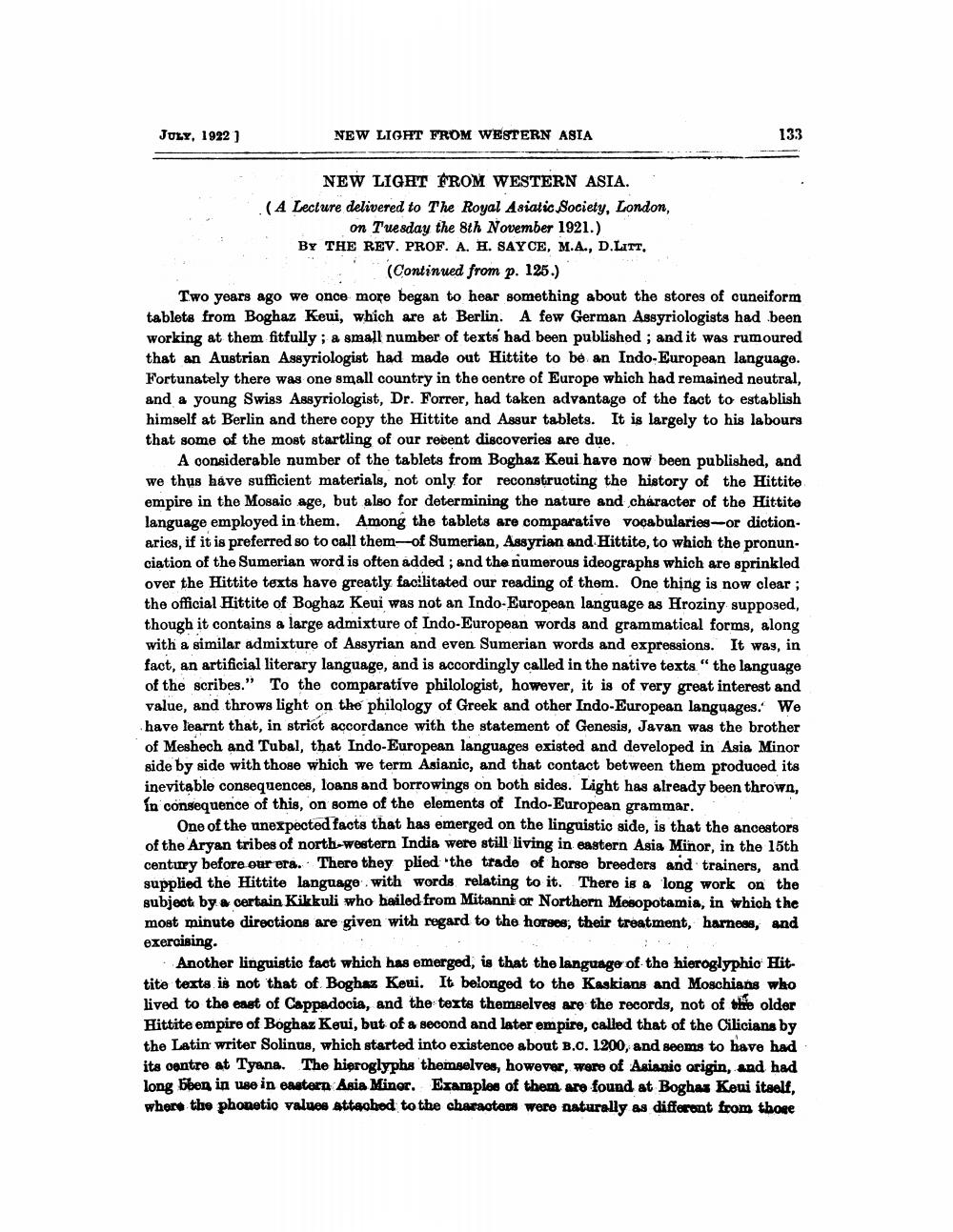________________
JULY, 1922)
NEW LIGHT FROM WESTERN ASIA
133
NEW LIGHT FROM WESTERN ASIA. . (A Lecture delivered to The Royal Asiatic Society, London,
on Tuesday the 8th November 1921.) BY THE REV. PROF. A. H. SAY CE, M.A., D.LITT,
(Continued from p. 125.) Two years ago we once more began to hear something about the stores of cuneiform tablete from Boghaz Keui, which are at Berlin. A few German Assyriologists had been working at them fitfully; a small number of texts had been published ; and it was rumoured that an Austrian Assyriologist had made out Hittite to be an Indo-European language. Fortunately there was one small country in the centre of Europe which had remained neutral, and a young Swiss Assyriologist, Dr. Forrer, had taken advantage of the fact to establish himself at Berlin and there copy the Hittite and Assur tablets. It is largely to his labours that some of the most startling of our recent discoveries are due.
A considerable number of the tablets from Boghaz Keui have now been published, and we thus háve sufficient materials, not only for reconstructing the history of the Hittite empire in the Mosaic age, but also for determining the nature and character of the Hittite language employed in them. Among the tablets are comparative vocabularies-or dictionaries, if it is preferred so to call them of Sumerian, Assyrian and Hittite, to which the pronun. ciation of the Sumerian word is often added ; and the numerous ideographs which are sprinkled over the Hittite texts have greatly facilitated our reading of them. One thing is now clear ; the official Hittite of Boghaz Keui was not an Indo-European language as Hroziny supposed, though it contains a large admixture of Indo-European words and grammatical forms, along with a similar admixture of Assyrian and even Sumerian words and expressions. It was, in fact, an artificial literary language, and is accordingly called in the native texts" the language of the scribes." To the comparative philologist, however, it is of very great interest and value, and throws light on the philology of Greek and other Indo-European languages. We have learnt that, in strict accordance with the statement of Genesis, Javan was the brother of Meshech and Tubal, that Indo-European languages existed and developed in Asia Minor side by side with those which we term Asianic, and that contact between them produced its inevitable consequences, loans and borrowings on both sides. Light has already been thrown, in consequence of this, on some of the elements of Indo-European grammar.
One of the unexpected facts that has emerged on the linguistic side, is that the ancestors of the Aryan tribes of north-western India were still living in eastern Asia Minor, in the 15th century before our era. There they plied the trade of horse breeders and trainers, and supplied the Hittite language with words relating to it. There is a long work on the subject by a certain Kikkuli who hailed from Mitanni or Northern Mesopotamia, in which the most minute directions are given with regard to the horses, their treatment, harness, and exercising.
Another linguistic fact which has emerged, is that the language of the hieroglyphic Hittite texts is not that of Boghaz Keui. It belonged to the Kaskians and Moschians who lived to the east of Cappadocia, and the texts themselves are the records, not of the older Hittite empire of Boghaz Keui, but of a second and later empire, called that of the Cilicians by the Latin writer Solinus, which started into existence about B.O. 1200, and seems to have had its contre at Tyana. The hieroglyphs themselves, however, were of Asianic origin, and had long bben in use in eastern Asia Minor. Examples of them are found at Boghas Keui itself, where the phonetio values attached to the characters were naturally as different from those




